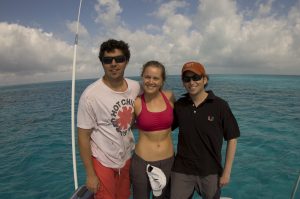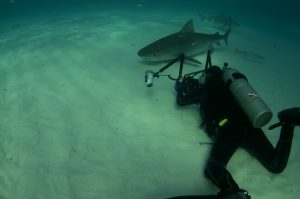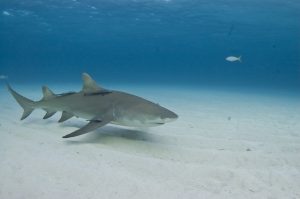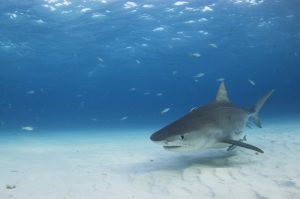“My Hero”
Our Bahamas expedition was a great success—truly an experience that reaffirms why we do what we do as researchers. The 5-day trip was a productive research trip, but also a really powerful and moving experience, thus I have named this entry after the Foo Fighters’ “My Hero.”
Off the west end of Freeport, Grand Bahama Island, we teamed up with Jim Abernethy’s Scuba Adventures for a tagging and ecotourism expedition to the famed Tiger Beach and its surrounding reefs.
The main goal of the expedition was to place as many satellite tags as possible on tiger, bull and hammerhead sharks. For the first two days, we set our drumlines and began catching various species. After the first day, we had put out 11 satellite tags, on sharks that ranged from 9-12 feet. We also satellite tagged a 13.5 ft female tiger shark, which was the largest of the species we have ever tagged! After seeing an animal that size up close, it brings a new meaning to the phrase “super predator.”
All of the tiger sharks tagged were female, and all were released quickly, swimming off in great condition. We also put out a satellite tag on each a bull and a great hammerhead. The next day, more tags were deployed, bringing our total to 16 satellite tags deployed in just two days! We are so anxious to see where these animals go—but more importantly, to figure out how it relates to their biological life history (ie. Do they follow patterns? Do they have specific breeding grounds? If so, do they congregate?, etc.). In the end, we hope the data will reveal important findings needed to effectively manage important shark areas such as the Bahamas.
I am also incredibly excited to report that both Dr. Hammerschlag and myself got the worst shark burn of our lives. It was more like 3rd degree shark burn. (For those of you that don’t know, shark burn occurs when you rub against a shark’s dermal denticles, essentially affecting the skin like rubbing it against sandpaper would.) It’s all worth it, though! Skin grows back eventually, and in RJD we wear shark burn with pride as a showing of our gratefulness for getting to work with these amazing animals.
The group of photographers and shark enthusiasts on board were extremely helpful and excited to participate in our research. After exhausting our supply of satellite tags, the next logistical thing to do was to go diving with the sharks.
It’s one thing to tag and release large sharks, but it is also important to spend time with the animals in their natural habitat. We were lucky to do just that—Jim Abernethy’s local knowledge and experience diving with large sharks was a key asset to the expedition. Our first day of diving had us at about 30 feet on a reef with 50-60 Caribbean reef sharks—we also spent time with 2 tigers and 1 bull on this dive. The rest of our dives were at Tiger Beach—a large sandy flat of 15 feet, which provides unbelievable viewing and photo opportunities for lemon and tiger sharks.
After a few more relaxed dives at Tiger Beach, we dropped in for our final dive on the sandy flat. Our group was greeted by 12 tiger sharks, all of which were around 10-12 feet long. On these dives, communication is key among dive buddies. It was truly surreal to spend time with the animals you study up close. Besides being stunning to observe, the tigers are amazing because they seem to “know” they are tigers…they swim with a sense of authority and grace you would expect from an apex predator. When you make eye contact with them (which is really important), its like you can actually see them thinking, calculating, and planning their next move. Shark ecotourism is an incredibly important driver of shark conservation, and I cannot stress how important spending time in the water with sharks really is. It was the perfect ending to the trip.
Coming up the dive ladder for the last time, I knew we had connected to the sharks of the Bahamas in many ways. We will be watching and monitoring them as they live their lives—lives filled with many risks and threats. While we are indeed hoping to bring forward new data for their protection, it is the sharks that are the heroes to us.
“There goes my hero, watch her as she goes…”
CLICK HERE TO WATCH A SHORT VIDEO ABOUT OUR BAHAMAS SHARK RESEARCH EXPEDITION
-Austin Gallagher, RJD Shark Research Assistant





So awesome! Great pictures. I love sharks but I got to say I would be a tad bit nervous…